Recent Development of Mid-Infrared Supercontinuum Generation in Fluoroindate Glass Fibers
Abstract
:1. Introduction
2. Fluoroindate Fibers—Design and Material Properties
3. Mid-Infrared Supercontinuum Generation Using Femtosecond Pulses
4. Mid-Infrared Supercontinuum Generation Using Optical Parametric Oscillators and Amplifiers Delivering Picosecond Pulses
5. Mid-Infrared Supercontinuum Generation Using Fiber MOPA Seeded with 1.55 µm Pulses
6. Mid-Infrared Supercontinuum Generation Using Fiber MOPA Seeded with 2 µm Pulses
7. Mid-Infrared Supercontinuum Generation Using 2 µm Pulses Emitted by Q-Switched/Gain-Switched and Mode-Locked Laser Systems
8. Summary and Outlook
Funding
Institutional Review Board Statement
Informed Consent Statement
Data Availability Statement
Acknowledgments
Conflicts of Interest
References
- Atkins, P.W. The Elements of Physical Chemistry; Oxford University Press: Oxford, UK, 1992. [Google Scholar]
- Henderson-Sapir, O.; Malouf, A.; Bawden, N.; Munch, J.; Jackson, S.D.; Ottaway, D.J. Recent advances in 3.5 μm erbium-doped mid-infrared fiber lasers. IEEE J. Sel. Top. Quantum Electron. 2017, 23, 6–14. [Google Scholar] [CrossRef] [Green Version]
- Islam, M.N.; Freeman, M.J.; Peterson, L.M.; Ke, K.; Ifarraguerri, A.; Bailey, C.; Baxley, F.; Wager, M.; Absi, A.; Leonard, J.; et al. Field tests for round-trip imaging at a 1.4 km distance with change detection and ranging using a short-wave infrared supercontinuum laser. Appl. Opt. 2016, 55, 1584–1602. [Google Scholar] [CrossRef] [PubMed] [Green Version]
- Borondics, F.; Jossent, M.; Sandt, C.; Lavoute, L.; Gaponov, D.; Hideur, A.; Dumas, P.; Février, S. Supercontinuum-based Fourier transform infrared spectromicroscopy. Optica 2018, 5, 378–381. [Google Scholar] [CrossRef]
- Mandon, J.; Sorokin, E.; Sorokina, I.T.; Guelachvili, G.; Picqué, N. Supercontinua for high-resolution absorption multiplex infrared spectroscopy. Opt. Lett. 2008, 33, 285–287. [Google Scholar] [CrossRef] [Green Version]
- Lambert-Girard, S.; Allard, M.; Piché, M.; Babin, F. Differential optical absorption spectroscopy lidar for mid-infrared gaseous measurements. Appl. Opt. 2015, 54, 1647–1656. [Google Scholar] [CrossRef]
- Jahromi, K.E.; Pan, Q.; Hogstedt, L.; Friis, S.M.M.; Khodabakhsh, A.; Moselund, P.M.; Harren, F.J.M. Mid-infrared supercontinuum-based upconversion detection for trace gas sensing. Opt. Express 2019, 27, 24469–24480. [Google Scholar] [CrossRef] [PubMed]
- Walsh, B.M.; Lee, H.R.; Barnes, N.P. Mid infrared lasers for remote sensing applications. J. Lumin. 2016, 169, 400–405. [Google Scholar] [CrossRef]
- Kumar, M.; Islam, M.N.; Terry, F.L.; Freeman, M.J.; Chan, A.; Neelakandan, M.; Manzur, T. Stand-off detection of solid targets with diffuse reflection spectroscopy using a high-power mid-infrared supercontinuum source. Appl. Opt. 2012, 51, 2794–2807. [Google Scholar] [CrossRef]
- Molocher, B. Countermeasure laser development. In Proceedings of the SPIE 5989, Technologies for Optical Countermeasures II; Femtosecond Phenomena II; and Passive Millimetre-Wave and Terahertz Imaging II, Bruges, Belgium, 26–28 September 2005; Kirkpatrick, S.M., Stoian, R., Titterton, D.H., Appleby, R., Chamberlain, J.M., Krapels, K.A., Eds.; International Society for Optics and Photonics: Bellingham, WA, USA, 2005; p. 598902. [Google Scholar]
- Bekman, H.H.P.T.; van den Heuvel, J.C.; van Putten, F.J.M.; Schleijpen, R. Development of a mid-infrared laser for study of infrared countermeasures techniques. In Proceedings of the SPIE 5615, Technologies for Optical Countermeasures, London, UK, 25–28 October 2004; Titterton, D.H., Ed.; International Society for Optics and Photonics: Bellingham, WA, USA, 2004; pp. 27–38. [Google Scholar]
- Tholl, H.D. Review and prospects of optical countermeasure technologies. In Proceedings of the SPIE 10797, Technologies for Optical Countermeasures XV, Berlin, Germany, 10–13 September 2018; Titterton, D.H., Grasso, R.J., Richardson, M.A., Eds.; International Society for Optics and Photonics: Bellingham, WA, USA, 2018; p. 1079702. [Google Scholar]
- Seddon, A.B. MIR photonics: MIR passive and active fiber-optics chemical and biomedical, sensing and imaging. In Proceedings of the SPIE 9992, Emerging Imaging and Sensing Technologies, Edinburgh, UK, 26–29 September 2016; Lewis, K.L., Hollins, R.C., Eds.; International Society for Optics and Photonics: Bellingham, WA, USA, 2016; p. 999206. [Google Scholar]
- Anderson, R.R.; Farinelli, W.; Laubach, H.; Manstein, D.; Yaroslavsky, A.N.; Gubeli, J., III; Jordan, K.; Neil, G.R.; Shinn, M.; Chandler, W.; et al. Selective photothermolysis of lipid-rich tissues: A free electron laser study. Lasers Surg. Med. 2006, 38, 913–919. [Google Scholar] [CrossRef]
- Petersen, C.R.; Prtljaga, N.; Farries, M.; Ward, J.; Napier, B.; Lloyd, G.R.; Nallala, J.; Stone, N.; Bang, O. Mid infrared multispectral tissue imaging using a chalcogenide fiber supercontinuum source. Opt. Lett. 2018, 43, 999–1002. [Google Scholar] [CrossRef]
- Labruyere, A.; Tonello, A.; Couderc, V.; Huss, G.; Leproux, P. Compact supercontinuum sources and their biomedical applications. Opt. Fiber Technol. 2012, 18, 375–378. [Google Scholar] [CrossRef]
- Kim, S.; Young, C.; Vidakovic, B.; Gabram-Mendola, S.G.A.; Bayer, C.W.; Mizaikoff, B. Potential and challenges for mid-infrared sensors in breath diagnostics. IEEE Sens. J. 2010, 10, 145–158. [Google Scholar] [CrossRef]
- Seddon, A.B. Mid-infrared (IR)—A hot topic: The potential for using mid-IR light for non-invasive early detection of skin cancer in vivo. Phys. Status Solidi B 2013, 250, 1020–1027. [Google Scholar] [CrossRef]
- Woodward, R.I.; Hudson, D.D.; Fuerbach, A.; Jackson, S.D. Generation of 70-fs pulses at 2.86 μm from a mid-infrared fiber laser. Opt. Lett. 2017, 42, 4893–4896. [Google Scholar] [CrossRef] [PubMed]
- Sanari, Y.; Sekiguchi, F.; Nakagawa, K.; Ishii, N.; Kanemitsu, Y.; Hirori, H. Generation of wavelength-tunable few-cycle pulses in the mid-infrared at repetition rates up to 10 kHz. Opt. Lett. 2021, 46, 5280–5283. [Google Scholar] [CrossRef]
- Tian, K.; He, L.; Yang, X.; Liang, H. Mid-infrared few-cycle pulse generation and amplification. Photonics 2021, 8, 290. [Google Scholar] [CrossRef]
- Hickstein, D.D.; Jung, H.; Carlson, D.R.; Lind, A.; Coddington, I.; Srinivasan, K.; Ycas, G.G.; Cole, D.C.; Kowligy, A.; Fredrick, C.; et al. Ultrabroadband supercontinuum generation and frequency-comb stabilization using on-chip waveguides with both cubic and quadratic nonlinearities. Phys. Rev. Appl. 2017, 8, 014025. [Google Scholar] [CrossRef] [Green Version]
- Alfano, R.R.; Shapiro, S.L. Direct distortion of electronic clouds of rare-gas atoms in intense electric fields. Phys. Rev. Lett. 1970, 24, 1217–1220. [Google Scholar] [CrossRef]
- Alfano, R.R.; Shapiro, S.L. Observation of self-phase modulation and small-scale filaments in crystals and glasses. Phys. Rev. Lett. 1970, 24, 592–594. [Google Scholar] [CrossRef]
- Dudley, J.M.; Taylor, R. (Eds.) Supercontinuum Generation in Optical Fibers; Cambridge University Press (CUP): Cambridge, UK, 2010. [Google Scholar]
- Dudley, J.M.; Genty, G.; Coen, S. Supercontinuum generation in photonic crystal fiber. Rev. Mod. Phys. 2006, 78, 1135–1184. [Google Scholar] [CrossRef]
- Husakou, A.V.; Herrmann, J. Supercontinuum generation of higher-order solitons by fission in photonic crystal fibers. Phys. Rev. Lett. 2001, 87, 203901. [Google Scholar] [CrossRef] [PubMed] [Green Version]
- Gordon, J.P. Theory of the soliton self-frequency shift. Opt. Lett. 1986, 11, 662–664. [Google Scholar] [CrossRef] [PubMed]
- Genty, G.; Coen, S.; Dudley, J.M. Fiber supercontinuum sources. J. Opt. Soc. Am. B 2007, 24, 1771–1785. [Google Scholar] [CrossRef]
- Agrawal, G.P. Nonlinear Fiber Optics, 4th ed.; Academic Press: Boston, MA, USA, 2007. [Google Scholar]
- Xia, C.; Kumar, M.; Cheng, M.Y.; Kulkarni, O.P.; Islam, M.N.; Galvanauskas, A.; Terry, F.L.; Freeman, M.J.; Nolan, D.A.; Wood, W.A. Supercontinuum generation in silica fibers by amplified nanosecond laser diode pulses. IEEE J. Sel. Top. Quantum Electron. 2007, 13, 789–797. [Google Scholar]
- Swiderski, J.; Maciejewska, M. Watt-level, all-fiber supercontinuum source based on telecom-grade fiber components. Appl. Phys. B 2012, 109, 177–181. [Google Scholar] [CrossRef] [Green Version]
- Romano, C.; Jaouen, Y.; Tench, R.E.; Delavaux, J.-M. Ultra-flat supercontinuum from 1.95 to 2.65 µm in a nanosecond pulsed thulium-doped fiber laser. Opt. Fiber Technol. 2020, 54, 102113. [Google Scholar] [CrossRef]
- Lagsgaard, J.; Tu, H. How long wavelengths can one extract from silica-core fibers. Opt. Lett. 2013, 38, 4518–4521. [Google Scholar] [CrossRef] [Green Version]
- Yin, K.; Zhang, B.; Yao, J.; Yang, L.; Liu, G.; Hou, J. 1.9–3.6 μm supercontinuum generation in a very short highly nonlinear germania fiber with a high mid-infrared power ratio. Opt. Lett. 2016, 41, 5067–5070. [Google Scholar] [CrossRef]
- Jain, D.; Sidharthan, R.; Woyessa, G.; Moselund, P.M.; Bowen, P.; Yoo, S.; Bang, O. Scaling power, bandwidth, and efficiency of mid-infrared supercontinuum source based on a GeO2-doped silica fiber. J. Opt. Soc. Am. B 2019, 36, A86–A92. [Google Scholar] [CrossRef]
- Swiderski, J.; Michalska, M.; Grzes, P. Broadband and top-flat mid-infrared supercontinuum generation with 3.52 W time-averaged power in a ZBLAN fiber directly pumped by a 2-µm mode-locked fiber laser and amplifier. Appl. Phys. B 2018, 124, 152. [Google Scholar] [CrossRef] [Green Version]
- Yin, K.; Zhang, B.; Yang, L.; Hou, J. 15.2 W spectrally flat all-fiber supercontinuum laser source with >1 W power beyond 3.8 μm. Opt. Lett. 2017, 42, 2334–2337. [Google Scholar] [CrossRef] [PubMed]
- Liu, K.; Liu, J.; Shi, H.; Tan, F.; Wang, P. High power mid-infrared supercontinuum generation in a single-mode ZBLAN fiber with up to 21.8 W average output power. Opt. Express 2014, 22, 24384–24391. [Google Scholar] [CrossRef] [PubMed]
- Michalska, M.; Hlubina, P.; Swiderski, J. Mid-infrared supercontinuum generation to ~4.7 µm in a ZBLAN fiber pumped by an optical parametric generator. IEEE Photonics J. 2017, 9, 1–7. [Google Scholar] [CrossRef] [Green Version]
- Yang, L.; Li, Y.; Zhang, B.; Wu, T.; Zhao, Y.; Hou, J. 30-W supercontinuum generation based on ZBLAN fiber in an all-fiber configuration. Photonics Res. 2019, 7, 1061–1065. [Google Scholar] [CrossRef]
- Wu, T.; Yang, L.; Dou, Z.; Yin, K.; He, X.; Zhang, B.; Hou, J. Ultra-efficient, 10-watt-level mid-infrared supercontinuum generation in fluoroindate fiber. Opt. Lett. 2019, 44, 2378–2381. [Google Scholar] [CrossRef]
- Grzes, P.; Swiderski, J. Gain-switched 2-µm fiber laser system providing kilowatt peak-power mode-locked resembling pulses and its application to supercontinuum generation in fluoride fibers. IEEE Photonics J. 2018, 10, 1–8. [Google Scholar] [CrossRef]
- Xia, C.; Xu, Z.; Islam, M.N.; Terry, J.F.L.; Freeman, M.J.; Zakel, A.; Mauricio, J. 10.5 W time-averaged power mid-IR supercontinuum generation extending beyond 4 µm with direct pulse pattern modulation. IEEE J. Sel. Top. Quantum Electron. 2009, 15, 422–434. [Google Scholar] [CrossRef]
- Venck, S.; St-Hilaire, F.; Brilland, L.; Ghosh, A.N.; Chahal, R.; Caillaud, C.; Meneghetti, M.; Troles, J.; Joulain, F.; Cozic, S.; et al. 2–10 µm mid-infrared fiber-based supercontinuum laser source: Experiment and simulation. Laser Photonics Rev. 2020, 14, 2000011. [Google Scholar] [CrossRef]
- Thapa, R.; Rhonehouse, D.; Nguyen, D.; Wiersma, K.; Smith, C.; Zong, J.; Chavez-Pirson, A. Mid-IR supercontinuum generation in ultralow loss, dispersion-zero shifted tellurite glass fiber with extended coverage beyond 4.5 µm. In Proceedings of the SPIE 8898, Technologies for Optical Countermeasures X; and High-Power Lasers 2013: Technology and Systems, Dresden, Germany, 23–26 September 2013; Titterton, D.H., Richardson, M.A., Grasso, R.J., Ackermann, H., Bohn, W.L., Eds.; International Society for Optics and Photonics: Bellingham, WA, USA, 2013; p. 889808. [Google Scholar]
- Désévédavy, F.; Gadret, G.; Jules, J.-C.; Kibler, B.; Smektala, F. Supercontinuum generation in tellurite optical fibers. In Springer Series in Materials Science, Technological Advances in Tellurite Glasses; Rivera, V., Manzani, D., Eds.; Springer International Publishing AG: Berlin/Heidelberg, Germany, 2017; Volume 254, pp. 277–299. [Google Scholar]
- Lemiere, A.; Maldonado, A.; Désévédavy, F.; Kibler, B.; Mathey, P.; Gadret, G.; Jules, J.-C.; Hoa, N.P.T.; Suzuki, T.; Ohishi, Y.; et al. Towards absorption spectroscopy by means of mid-infrared supercontinuum generation in a step index tellurite fiber. Laser Phys. 2021, 31, 025702. [Google Scholar] [CrossRef]
- Zhang, B.; Yu, Y.; Zhai, C.; Qi, S.; Wang, Y.; Yang, A.; Gai, X.; Wang, R.; Yang, Z.; Luther-Davies, B. High brightness 2.2-12 µm mid-infrared supercontinuum generation in a nontoxic chalcogenide step-index fiber. J. Am. Ceram. Soc. 2016, 99, 2565–2568. [Google Scholar] [CrossRef]
- Cheng, T.; Nagasaka, K.; Tuan, T.H.; Xue, X.; Matsumoto, M.; Tezuka, H.; Suzuki, T.; Ohishi, Y. Mid-infrared supercontinuum generation spanning 2.0 to 15.1 µm in a chalcogenide step-index fiber. Opt. Lett. 2016, 41, 2117–2120. [Google Scholar] [CrossRef] [PubMed]
- Kedenburg, S.; Steinle, T.; Morz, F.; Steinmann, A.; Giessen, H. High-power mid-infrared high repetition-rate supercontinuum source based on a chalcogenide step-index fiber. Opt. Lett. 2015, 40, 2668–2671. [Google Scholar] [CrossRef] [PubMed]
- Wang, Y.; Dai, S. Mid-infrared supercontinuum generation in chalcogenide glass fibers: A brief review. PhotoniX 2021, 2, 9. [Google Scholar] [CrossRef]
- Lemiere, A.; Bizot, R.; Désévédavy, F.; Gadret, G.; Jules, J.-C.; Mathey, P.; Aquilina, C.; Béjot, P.; Billard, F.; Faucher, O.; et al. 1.7-18 µm mid-infrared supercontinuum generation in a dispersion engineered step-index chalcogenide fiber. Results Phys. 2021, 26, 104397. [Google Scholar] [CrossRef]
- Woyessa, G.; Kwarkye, K.; Dasa, M.K.; Petersen, C.R.; Sidharthan, R.; Chen, S.; Yoo, S.; Bang, O. Power stable 1.5–10.5 µm cascaded mid-infrared supercontinuum laser without thulium amplifier. Opt. Lett. 2021, 46, 1129–1132. [Google Scholar] [CrossRef]
- Petersen, C.R.; Moller, U.; Kubat, I.; Zhou, B.; Dupont, S.; Ramsay, J.; Benson, T.; Sujecki, S.; Abdel-Moneim, N.; Tang, Z.; et al. Mid-infrared supercontinuum covering the 1.4-13.3 µm molecular fingerprint region using ultra-high NA chalcogenide step-index fibre. Nat. Photonics 2014, 8, 830–834. [Google Scholar] [CrossRef]
- Saad, M. Indium fluoride glass fibres. In Proceedings of the SPIE 8275, Laser Refrigeration of Solids V, San Francisco, CA, USA, 21–26 January 2012; Epstein, R.I., Sheik-Bahae, M., Eds.; International Society for Optics and Photonics: Bellingham, WA, USA, 2012; p. 82750D. [Google Scholar]
- Bei, J.; Monro, T.M.; Hemming, A.; Ebendorff-Heidepriem, H. Reduction of scattering loss in fluoroindate glass fibers. Opt. Mater. Express 2013, 3, 1285–1301. [Google Scholar] [CrossRef] [Green Version]
- Gauthier, J.-C.; Fortin, V.; Carrée, J.-Y.; Poulain, S.; Vallée, R.; Bernier, M. Mid-IR supercontinuum from 2.4 to 5.4 µm in a low-loss fluoroindate fiber. Opt. Lett. 2016, 41, 1756–1759. [Google Scholar] [CrossRef]
- Théberge, F.; Bérubé, N.; Poulain, S.; Cozic, S.; Robichaud, L.-R.; Bernier, M.; Vallée, R. Watt-level and spectrally flat mid-infrared supercontinuum in fluoroindate fibers. Photon. Res. 2018, 6, 609–613. [Google Scholar] [CrossRef]
- Yang, L.; Zhang, B.; Jin, D.; Wu, T.; He, X.; Zhao, Y.; Hou, J. All-fiberized, multi-watt 2-5-µm supercontinuum laser source based on fluoroindate fiber with record conversion efficiency. Opt. Lett. 2018, 43, 5206–5209. [Google Scholar] [CrossRef]
- Yang, L.; Zhang, B.; He, X.; Deng, K.; Liu, S.; Hou, J. High-power mid-infrared supercontinuum generation in a fluoroindate fiber with over 2 W power beyond 3.8 µm. Opt. Express 2020, 28, 14973–14979. [Google Scholar] [CrossRef] [PubMed]
- Kedenburg, S.; Strutynski, C.; Kibler, B.; Froidevaux, P.; Désévédavy, F.; Gadret, G.; Jules, J.-C.; Steinle, T.; Mörz, F.; Steinmann, A.; et al. High repetition rate mid-infrared supercontinuum generation from 1.3 to 5.3 µm in robust step-index tellurite fibers. J. Opt. Soc. Am. B 2017, 34, 601–607. [Google Scholar] [CrossRef]
- Froidevaux, P.; Lemiere, A.; Kibler, B.; Désévédavy, F.; Mathey, P.; Gadret, G.; Jules, J.-C.; Nagasaka, K.; Suzuki, T.; Ohishi, Y.; et al. Dispersion-engineered step-index tellurite fibers for mid-infrared coherent supercontinuum generation from 1.5 to 4.5 µm with sub-nanojoule femtosecond pump pulses. Appl. Sci. 2018, 8, 1875. [Google Scholar] [CrossRef] [Green Version]
- Li, Z.; Jia, Z.; Yao, C.; Zhao, Z.; Li, N.; Hu, M.; Ohishi, Y.; Qin, W.; Qin, G. 22.7 W mid-infrared supercontinuum generation in fluorotellurite fibers. Opt. Lett. 2020, 45, 1882–1885. [Google Scholar] [CrossRef]
- Sanghera, J.S.; Florea, C.M.; Shaw, L.B.; Pureza, P.; Nquyen, V.Q.; Bashkansky, M.; Dutton, Z.; Aggarwal, I.D. Active and passive chalcogenide glass optical fibers for IR applications: A review. J. Non-Cryst. Solids 2008, 354, 462–467. [Google Scholar] [CrossRef]
- Jiao, K.; Yao, J.; Zhao, Z.; Wang, X.; Si, N.; Wang, X.; Chen, P.; Xue, Z.; Tian, Y.; Zhang, B.; et al. Mid-infrared flattened supercontinuum generation in all-normal dispersion tellurium chalcogenide fiber. Opt. Express 2019, 27, 2036–2043. [Google Scholar] [CrossRef]
- Martinez, R.A.; Plant, G.; Guo, K.; Janiszewski, B.; Freeman, M.J.; Maynard, R.L.; Islam, M.N.; Terry, F.L.; Alvarez, O.; Chenard, F.; et al. Mid-infrared supercontinuum generation from 1.6 to >11 µm using concatenated step-index fluoride and chalcogenide fibers. Opt. Lett. 2018, 43, 296–299. [Google Scholar] [CrossRef]
- Yan, B.; Huang, T.; Zhang, W.; Wang, J.; Yang, L.; Yang, P.; Xia, K.; Bai, S.; Zhao, R.; Wu, D.; et al. Generation of watt-level supercontinuum covering 2-6.5 µm in an all-fiber structured infrared nonlinear transmission system. Opt. Express 2021, 29, 4048–4057. [Google Scholar] [CrossRef]
- White, R.T.; Monro, T.M. Cascaded Raman shifting of high-peak-power nanosecond pulses in As2S3 and As2Se3 optical fibers. Opt. Lett. 2011, 36, 2351–2353. [Google Scholar] [CrossRef]
- Zhang, Y.; Xu, Y.; You, C.; Xu, D.; Tang, J.; Zhang, P.; Dai, S. Raman gain and femtosecond laser induced damage of Ge-As-S chalcogenide glasses. Opt. Express 2017, 25, 8886–8895. [Google Scholar] [CrossRef]
- Zhu, L.; Yang, D.; Wang, L.; Zeng, J.; Zhang, Q.; Xie, M.; Zhang, P.; Dai, S. Optical and thermal stability of Ge-as-Se chalcogenide glasses for femtosecond laser writing. Opt. Mater. 2018, 85, 220–225. [Google Scholar] [CrossRef]
- Poulain, M.; Poulain, M.; Lucas, J.; Brun, P. Verres fluores au tetrafluorure de zirconium proprietes optiques d’un verre dope au Nd3+. Mater. Res. Bull. 1975, 10, 243–246. [Google Scholar] [CrossRef]
- Maes, F.; Fortin, V.; Poulain, S.; Poulain, M.; Carrée, J.-Y.; Bernier, M.; Vallée, R. Room-temperature fiber laser at 3.92 µm. Optica 2018, 5, 761–764. [Google Scholar] [CrossRef]
- Zhu, X.; Peyghambarian, N. High-power ZBLAN glass fiber lasers: Review and prospect. Adv. Optoelectron. 2010, 2010, 501956. [Google Scholar] [CrossRef] [Green Version]
- Newburgh, G.A.; Dubinskii, M. Power and efficiency scaling of Er: ZBLAN fiber laser. Laser Phys. Lett. 2021, 18, 095102. [Google Scholar] [CrossRef]
- Shen, Y.; Wang, Y.; Zhu, F.; Ma, L.; Zhao, L.; Chen, Z.; Wang, H.; Huang, C.; Huang, K.; Feng, G. 200 µJ, 13 ns Er:ZBLAN mid-infrared fiber laser actively Q-switched by an electro-optic modulator. Opt. Lett. 2021, 46, 1141–1144. [Google Scholar] [CrossRef]
- Swiderski, J.; Grzes, P. High-power mid-IR supercontinuum generation in fluoroindate and arsenic sulfide fibers pumped by a broadband 1.9–2.7 µm all-fiber laser source. Opt. Laser Technol. 2021, 141, 107178. [Google Scholar] [CrossRef]
- Séguin, F.; Saad, M.; Orsini, P.; Baierl, D. Fluoride glass fiber for reliable Er:YAG and Er,Cr:YSGG laser power delivery. In Proceedings of the SPIE 6852, Optical Fibers and Sensors for Medical Diagnostics and Treatment Applications VIII, San Jose, CA, USA, 19–24 January 2008; Gannot, I., Ed.; International Society for Optics and Photonics: Bellingham, WA, USA, 2008; p. 68520D. [Google Scholar]
- Beltrán Bernal, L.M.; Canbaz, F.; Darwiche, S.E.; Nuss, K.M.R.; Friederich, N.F.; Cattin, P.C.; Zam, A. Optical fibers for endoscopic high-power Er:YAG laserosteotomy. J. Biomed. Opt. 2021, 26, 095002. [Google Scholar] [CrossRef]
- Monerie, M.; Alard, F.; Maze, G. Fabrication and characterisation of fluoride-glass single-mode fibres. Electron. Lett. 1985, 21, 1179–1181. [Google Scholar] [CrossRef]
- Saad, M. Fluoride glass fiber: State of the art. In Proceedings of the SPIE 7316, Fiber Optic Sensors and Applications VI, Orlando, FL, USA, 13–17 April 2009; p. 73160N. [Google Scholar]
- Almeida, R.M.; Pereira, J.C.; Messaddeq, Y.; Aegerter, M.A. Vibrational spectra and structure of fluoroindate glasses. J. Non-Cryst. Solids 1993, 161, 105–108. [Google Scholar] [CrossRef] [Green Version]
- Tao, G.; Ebendorff-Heidepriem, H.; Stolyarov, A.M.; Danto, S.; Badding, J.V.; Fink, Y.; Ballato, J.; Abouraddy, A.F. Infrared fibers. Adv. Opt. Photonics 2015, 7, 379–458. [Google Scholar] [CrossRef]
- Bartholomew, R.F.; Aitken, B.G.; Newhouse, M.A. Praseodymium-doped cadmium mixed halide glasses for 1.3 µm amplification. J. Non-Cryst. Solids 1995, 184, 229–233. [Google Scholar] [CrossRef]
- Fortin, V.; Bernier, M.; Carrier, J.; Vallée, R. Fluoride glass Raman fiber laser at 2185 nm. Opt. Lett. 2011, 36, 4152–4154. [Google Scholar] [CrossRef] [PubMed]
- Adam, J.-L. Fluoride glass research in France: Fundamentals and applications. J. Fluor. Chem. 2001, 107, 265–270. [Google Scholar] [CrossRef]
- France, P.W.; Drexhage, M.G.; Parker, J.M.; Moore, M.W.; Carter, S.F.; Wright, J.V. Fluoride Glass Optical Fibres; CRC Press, Inc.: Boca Raton, FL, USA, 1990. [Google Scholar]
- Shiryaev, V.; Churbanov, M. Trends and prospects for development of chalcogenide fibers for mid-infrared transmission. J. Non-Cryst. Solids 2013, 377, 225–230. [Google Scholar] [CrossRef]
- Saad, M. Heavy metal fluoride glass fibers and their applications. In Proceedings of the SPIE 8307, Passive Components and Fiber-Based Devices VIII, Shanghai, China, 13–16 November 2011; Pal, B.P., Ed.; International Society for Optics and Photonics: Bellingham, WA, USA, 2011; p. 83070N. [Google Scholar]
- Soufiane, A.; Gan, F.; L’Helgoualch, H.; Poulain, M. Material dispersion in optimized fluoroindate glasses. J. Non-Cryst. Solids 1995, 184, 36–39. [Google Scholar] [CrossRef]
- Basaldua, I.; Kuis, R.; Burkins, P.; Jiang, Z.; Johnson, A.M. Measurements of the nonlinear refractive index (n2) for indium fluoride (InF3) bulk glass and fiber. In Proceedings of the Frontiers in Optics/Laser Science, OSA Technical Digest, Optical Society of America, Paper JTu3A.38, Washington, DC, USA, 16–20 September 2018. [Google Scholar]
- Fedorov, P.P.; Zakalyukin, R.M.; Ignat’eva, L.N.; Bouznik, V.M. Fluoroindate glasses. Russ. Chem. Rev. 2000, 69, 705–716. [Google Scholar] [CrossRef]
- Available online: http://leverrefluore.com (accessed on 9 May 2022).
- Available online: https://www.thorlabs.com (accessed on 9 May 2022).
- Mitachi, S.; Terunuma, Y.; Ohishi, Y.; Takahashi, S. Reduction of impurities in fluoride glass fibers. J. Lightwave Technol. 1984, 2, 587–592. [Google Scholar] [CrossRef]
- Gan, F. Optical properties of fluoride glasses: A review. J. Non-Cryst. Solids 1995, 184, 9–20. [Google Scholar] [CrossRef]
- Saad, M. Advances in infrared fibers. In Proceedings of the SPIE 7839, 2nd Workshop on Specialty Optical Fibers and Their Applications (WSOF-2), Oaxaca, Mexico, 13–15 October 2010; Hernández-Cordero, J., Torres-Gómez, I., Méndez, A., Eds.; International Society for Optics and Photonics: Bellingham, WA, USA, 2010; p. 783905. [Google Scholar]
- Messaddeq, Y.; Delben, A.; Aegerter, M.A.; Soufiane, A.; Poulain, M. New fluoroindate glass compositions. J. Mater. Res. 1993, 8, 885–889. [Google Scholar] [CrossRef] [Green Version]
- Tran, D.C.; Sigel, G.H.; Bendow, B. Heavy metal fluoride glasses and fibers: A review. J. Lightwave Technol. 1984, 2, 566–586. [Google Scholar] [CrossRef]
- Bei, J.; Monro, T.M.; Hemming, A.; Ebendorff-Heidepriem, H. Fabrication of extruded fluoroindate optical fibers. Opt. Mater. Express 2013, 3, 318–328. [Google Scholar] [CrossRef]
- Théberge, F.; Daigle, J.-F.; Vincent, D.; Mathieu, P.; Fortin, J.; Schmidt, B.E.; Thiré, N.; Légaré, F. Mid-infrared supercontinuum generation in fluoroindate fiber. Opt. Lett. 2013, 38, 4683–4685. [Google Scholar] [CrossRef]
- Salem, R.; Jiang, Z.; Liu, D.; Pafchek, R.; Gardner, D.; Foy, P.; Saad, M.; Jenkins, D.; Cable, A.; Fendel, P. Mid-infrared supercontinuum generation spanning 1.8 octaves using step-index indium fluoride fiber pumped by a femtosecond fiber laser near 2 µm. Opt. Express 2015, 23, 30592–30602. [Google Scholar] [CrossRef] [PubMed]
- Michalska, M.; Mikolajczyk, J.; Wojtas, J.; Swiderski, J. Mid-infrared, super-flat, supercontinuum generation covering the 2–5 µm spectral band using a fluoroindate fibre pumped with picosecond pulses. Sci. Rep. 2016, 6, 39138. [Google Scholar] [CrossRef] [PubMed] [Green Version]
- Gauthier, J.C.; Robichaud, L.R.; Fortin, V.; Vallée, R.; Bernier, M. Mid-infrared supercontinuum generation in fluoride fiber amplifiers: Current status and future perspectives. Appl. Phys. B 2018, 124, 122. [Google Scholar] [CrossRef]
- Swiderski, J.; Michalska, M. Over three-octave spanning supercontinuum generated in a fluoride fiber pumped by Er & Er: Yb-doped and Tm-doped fiber amplifiers. Opt. Laser Technol. 2013, 52, 75–80. [Google Scholar]
- Swiderski, J.; Zajac, A.; Skorczakowski, M. Pulsed ytterbium-doped large mode area double-clad fiber amplifier in MOFPA configuration. Opto-Electron. Rev. 2007, 15, 98–101. [Google Scholar] [CrossRef]
- Du, X.; Zhang, H.; Ma, P.; Xiao, H.; Wang, X.; Zhou, P.; Liu, Z. Kilowatt-level fiber amplifier with spectral-broadening-free property, seeded by a random fiber laser. Opt. Lett. 2015, 40, 5311–5314. [Google Scholar] [CrossRef]
- Swiderski, J.; Dorosz, D.; Skorczakowski, M.; Pichola, W. Ytterbium-doped fiber amplifier with tunable repetition rate and pulse duration. Laser Phys. 2010, 20, 1–6. [Google Scholar] [CrossRef]
- Kudlinski, A.; Mussot, A. Optimization of continuous-wave supercontinuum generation. Opt. Fiber Technol. 2012, 18, 322–326. [Google Scholar] [CrossRef]
- Alexander, V.V.; Kulkarni, O.P.; Kumar, M.; Xia, C.; Islam, M.N.; Terry, F.L., Jr.; Welsh, M.J.; Ke, K.; Freeman, M.J.; Neelakandan, M.; et al. Modulation instability initiated high power all-fiber supercontinuum lasers and their applications. Opt. Fiber Technol. 2012, 18, 349–374. [Google Scholar] [CrossRef]
- Alexander, V.V.; Shi, Z.; Islam, M.N.; Ke, K.; Freeman, M.J.; Ifarraguerri, A.; Meola, J.; Absi, A.; Leonard, J.; Zadnik, J.; et al. Power scalable > 25 W supercontinuum laser from 2 to 2.5 µm with near-diffraction-limited beam and low output variability. Opt. Lett. 2013, 38, 2292–2294. [Google Scholar] [CrossRef] [PubMed] [Green Version]
- Yin, K.; Li, L.; Yao, J.; Zhang, B.; Hou, J. Over 100 W ultra-flat broadband short-wave infrared supercontinuum generation in a thulium-doped fiber amplifier. Opt. Lett. 2015, 40, 4787–4790. [Google Scholar] [CrossRef]
- Xia, C.; Kumar, M.; Kulkarni, O.P.; Islam, M.N.; Terry, F.L., Jr.; Freeman, M.J.; Poulain, M.; Maze, G. Mid-infrared supercontinuum generation to 4.5 µm in ZBLAN fluoride fibers by nanosecond diode pumping. Opt. Lett. 2006, 31, 2553–2555. [Google Scholar] [CrossRef]
- Liang, S.; Xu, L.; Fu, Q.; Jung, Y.; Shepherd, D.P.; Richardson, D.J.; Alam, S. 295-kW peak power picosecond pulses from a thulium-doped-fiber MOPA and the generation of watt-level > 2.5-octave supercontinuum extending up to 5 µm. Opt. Express 2018, 26, 6490–6498. [Google Scholar] [CrossRef] [Green Version]
- Swiderski, J.; Zajac, A.; Konieczny, P.; Skorczakowski, M. Q-switched Nd-doped double-clad fiber laser. Opto-Electron. Rev. 2005, 13, 29–33. [Google Scholar]
- Hakulinen, T.; Okhotnikov, O.G. 8 ns fiber laser Q switched by the resonant saturable absorber mirror. Opt. Lett. 2007, 32, 2677–2679. [Google Scholar] [CrossRef]
- Yao, B.; Zhang, D.; Zhang, J.; Wei, S.; Lin, X.; Mao, Q. Narrow-bandwidth actively Q-switched all-fiber laser by suppressing ASE gain self-saturation. Opt. Express 2019, 27, 27345–27353. [Google Scholar] [CrossRef]
- Shaodong, H.; Chengjin, L.; Haifeng, L.; Jinzhang, W.; Chunyu, G.; Jianqun, C.; Min, Z.; Peiguang, Y. Ultrafast thulium-doped fiber laser mode-locked by antimonides. Opt. Express 2021, 29, 13722–13732. [Google Scholar] [CrossRef]
- Hirooka, T.; Tokuhira, K.; Yoshida, M.; Nakazawa, M. 440 fs, 9.2 GHz regeneratively mode-locked erbium fiber laser with a combination of higher-order solitons and a SESAM saturable absorber. Opt. Express 2016, 24, 24255–24264. [Google Scholar] [CrossRef] [PubMed]
- Strickland, D.; Mourou, G. Compression of amplified chirped optical pulses. Opt. Commun. 1985, 56, 219–221. [Google Scholar] [CrossRef]
- Hubner, P.; Kieleck, C.; Jackson, S.D.; Eichhorn, M. High-power actively mode-locked sub-nanosecond Tm3+-doped silica fiber laser. Opt. Lett. 2011, 36, 2483–2485. [Google Scholar] [CrossRef] [PubMed]
- Scurria, G.; Manek-Hönninger, I.; Carré, J.Y.; Hildenbrand-Dhollande, A.; Bigotta, S. 7 W mid-infrared supercontinuum generation up to 4.7 µm in an indium-fluoride optical fiber pumped by a high-peak power thulium-doped fiber single-oscillator. Opt. Express 2020, 28, 7672–7677. [Google Scholar] [CrossRef]
- Swiderski, J.; Grzes, P.; Michalska, M. Mid-infrared supercontinuum generation of 1.14 W in a fluoroindate fiber pumped by a fast gain-switched and mode-locked thulium-doped fiber laser system. Appl. Opt. 2021, 60, 2647–2651. [Google Scholar] [CrossRef]
- Jiang, M.; Tayebati, P. Stable 10 ns, kilowatt peak-power pulse generation from a gain-switched Tm-doped fiber laser. Opt. Lett. 2007, 32, 1797–1799. [Google Scholar] [CrossRef]
- Swiderski, J.; Michalska, M.; Grzes, P. Mode-locking and selfmode-locking-like operation in a resonantly pumped gain-switched Tm-doped fiber laser. Opt. Commun. 2019, 453, 124406. [Google Scholar] [CrossRef]
- Aydin, Y.O.; Maes, F.; Fortin, V.; Bah, S.T.; Vallée, R.; Bernier, M. Endcapping of high-power 3 µm fiber lasers. Opt. Express 2019, 27, 20659–20669. [Google Scholar] [CrossRef]
- Michalska, M.; Grzes, P.; Hlubina, P.; Swiderski, J. Mid-infrared supercontinuum generation in a fluoroindate fiber with 1.4 W time-averaged power. Laser Phys. Lett. 2018, 15, 045101. [Google Scholar] [CrossRef]
- Théberge, F.; Bérubé, N.; Poulain, S.; Cozic, S.; Chatigny, S.; Robichaud, L.-R.; Pleau, L.-P.; Bernier, M.; Vallée, R. Infrared supercontinuum generated in concatenated InF3 and As2Se3 fibers. Opt. Express 2018, 26, 13952–13960. [Google Scholar] [CrossRef]

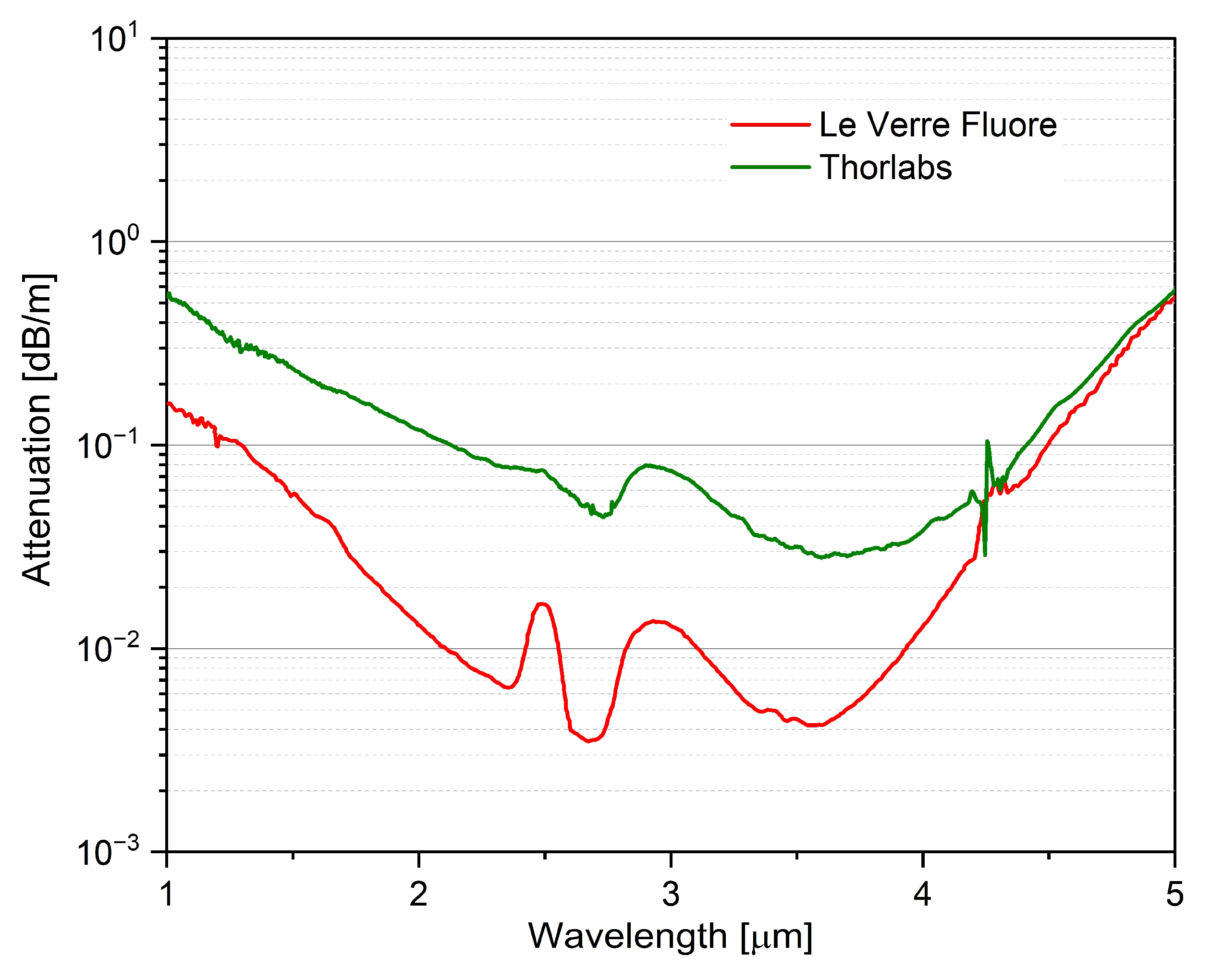

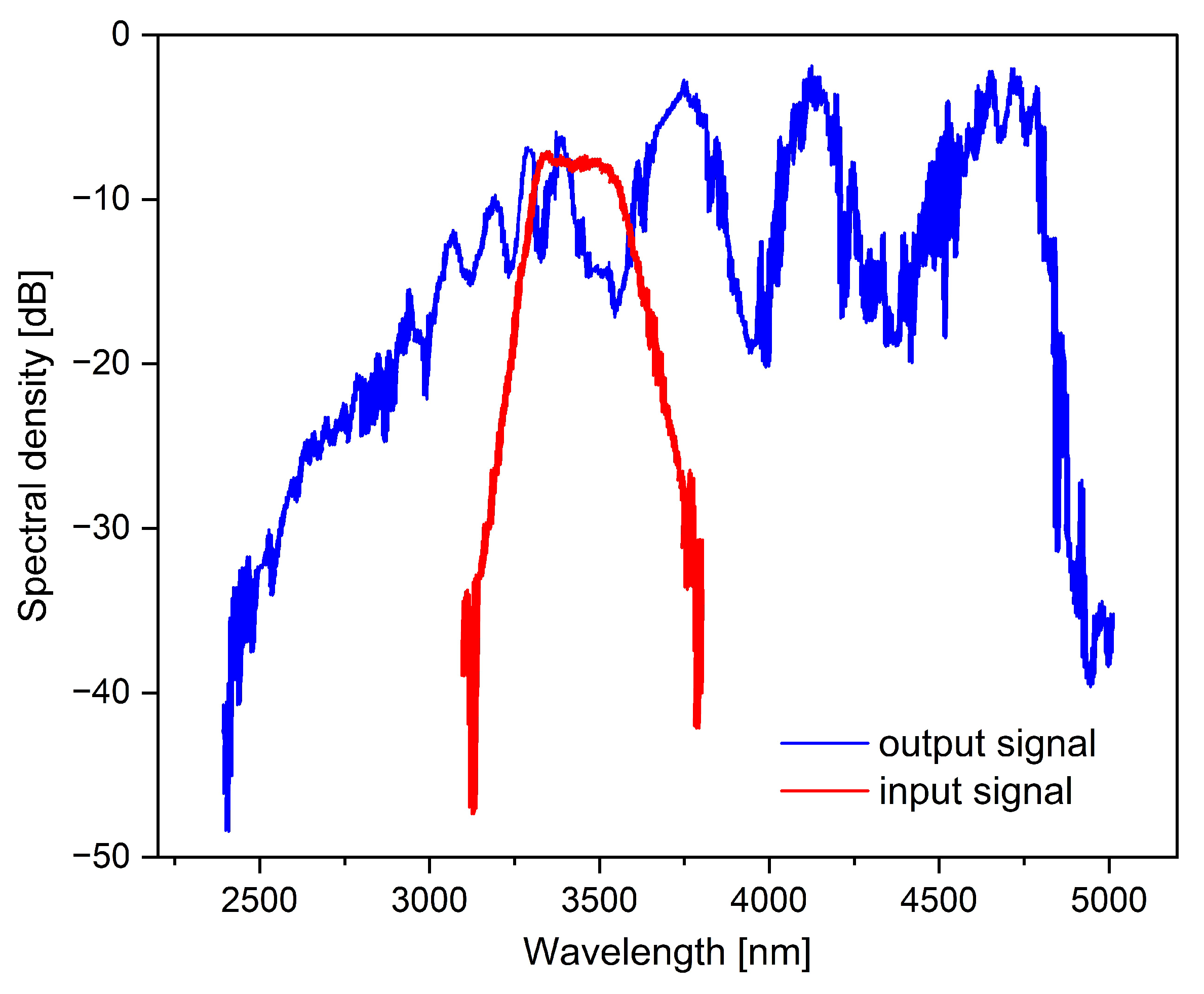

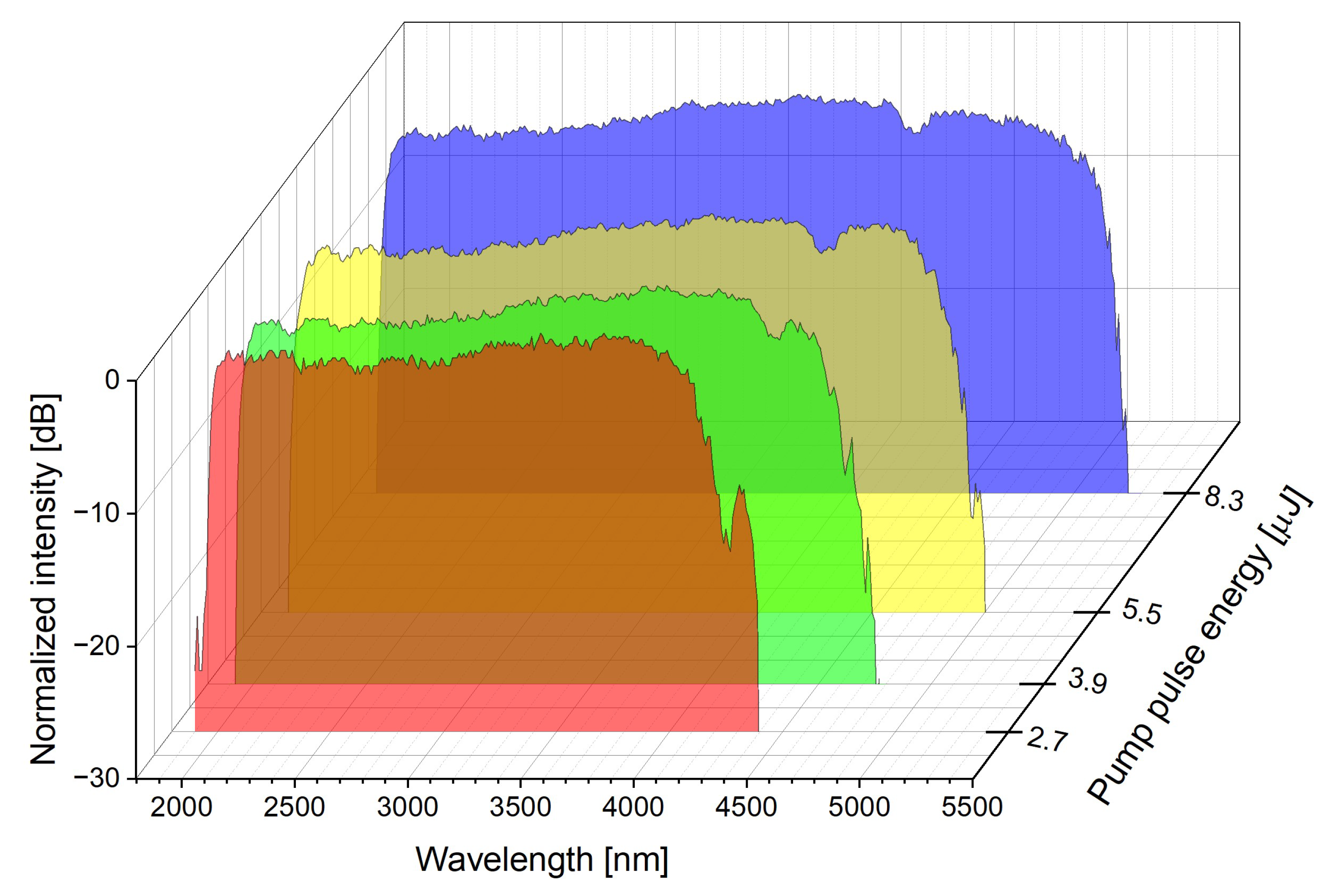
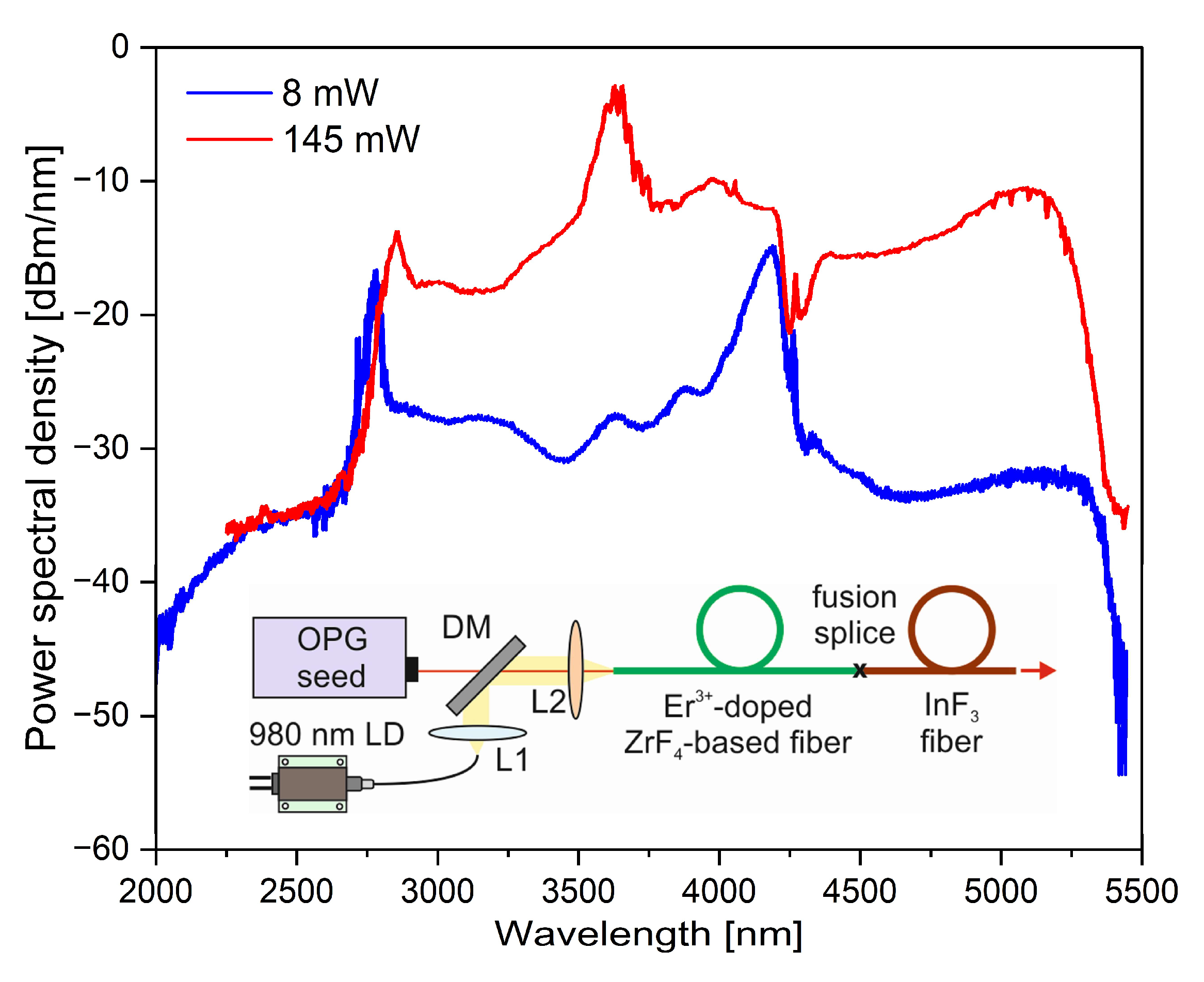

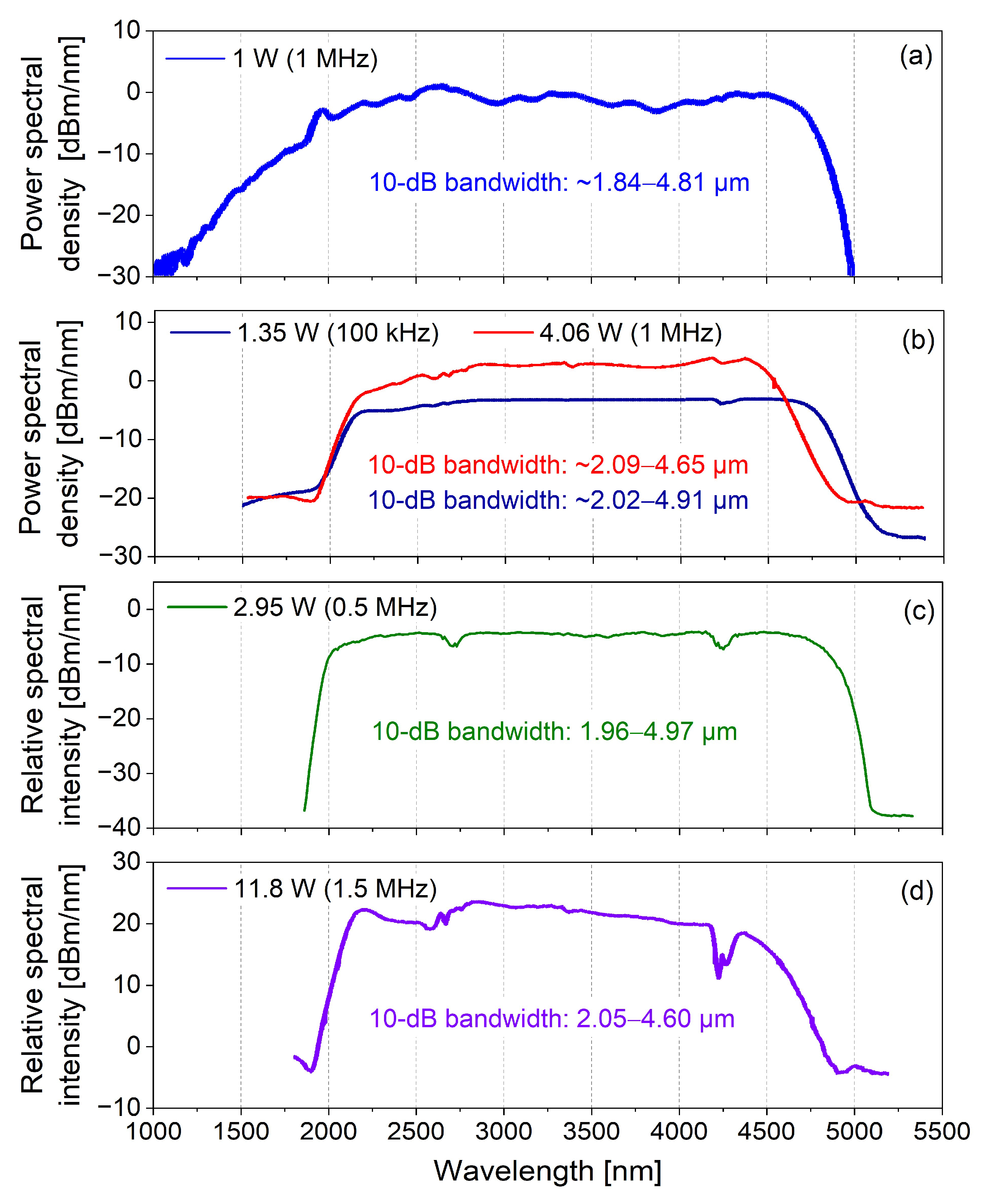
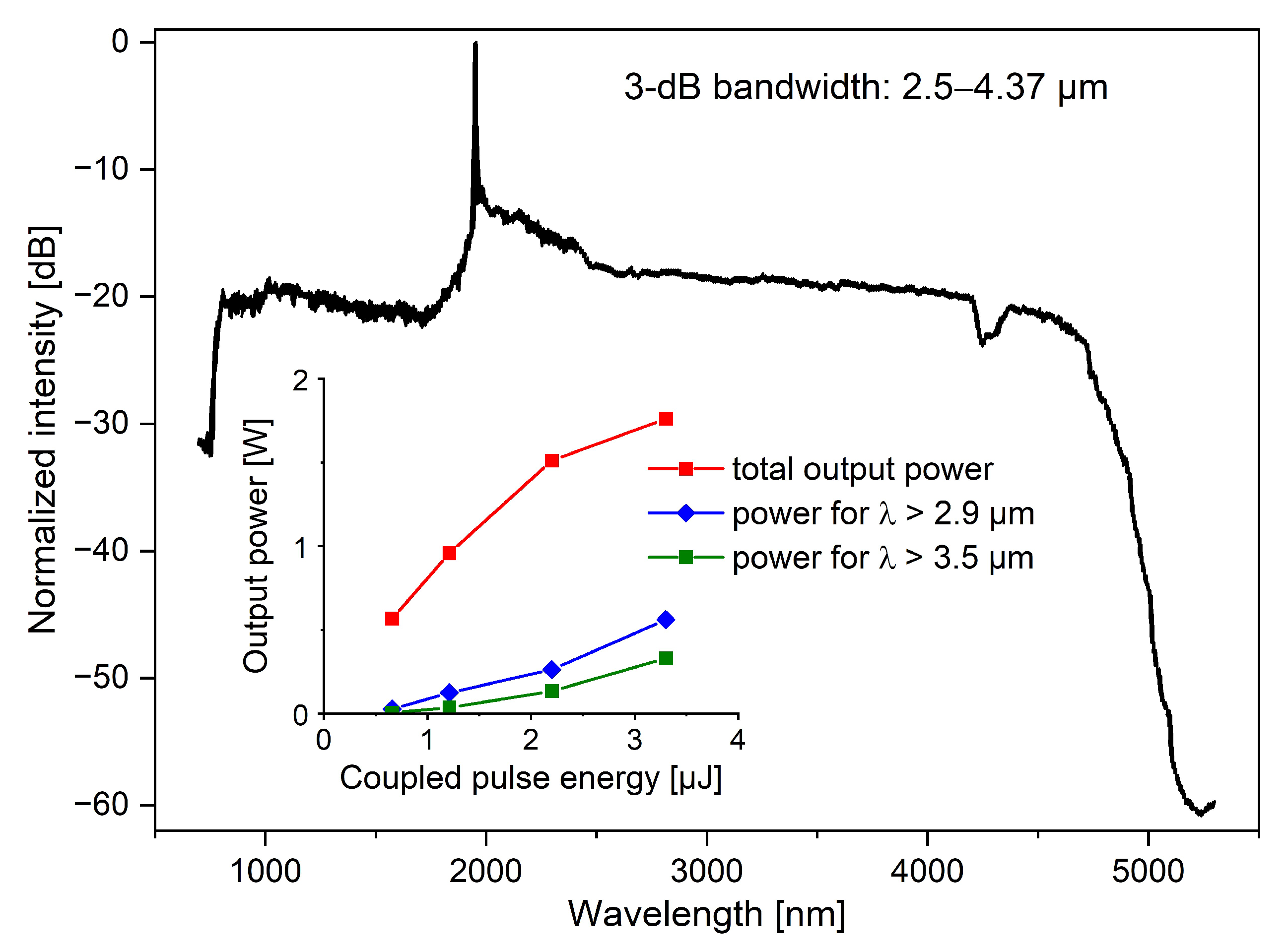
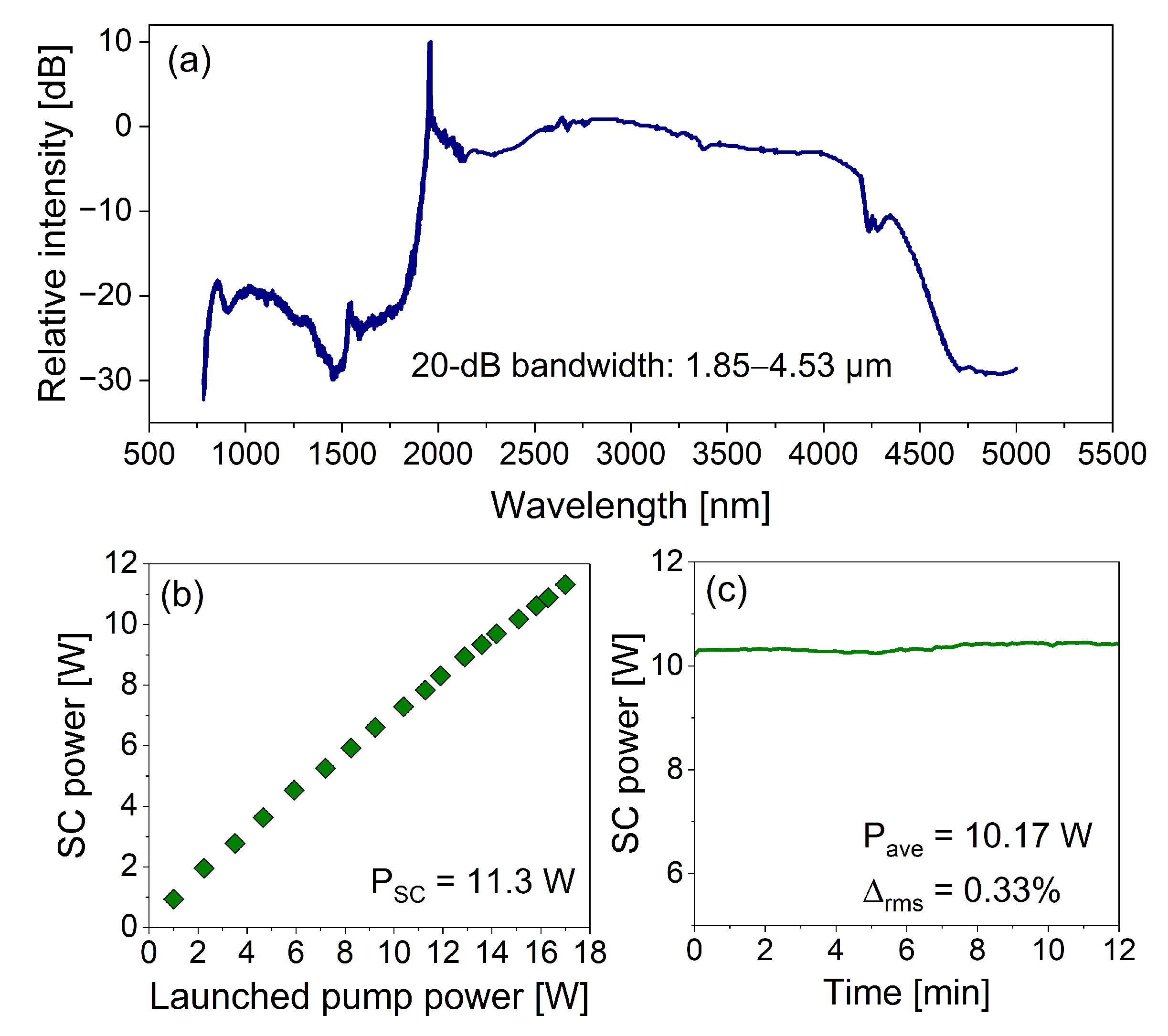
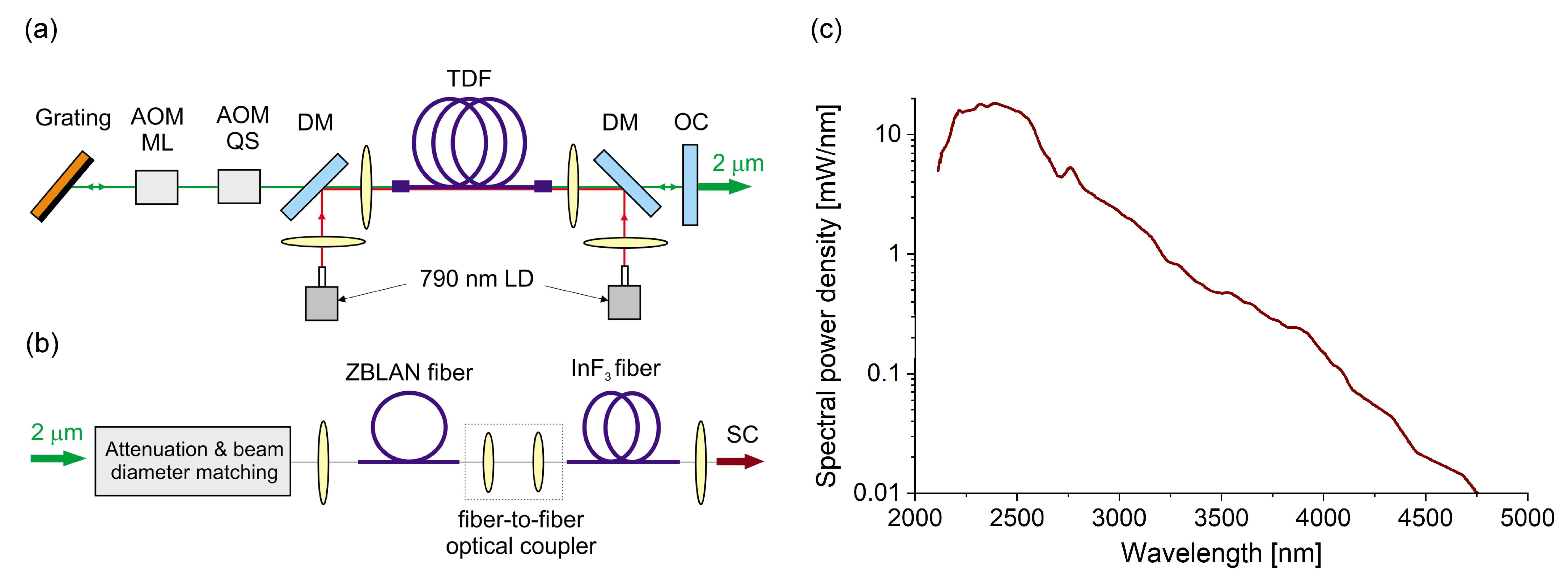
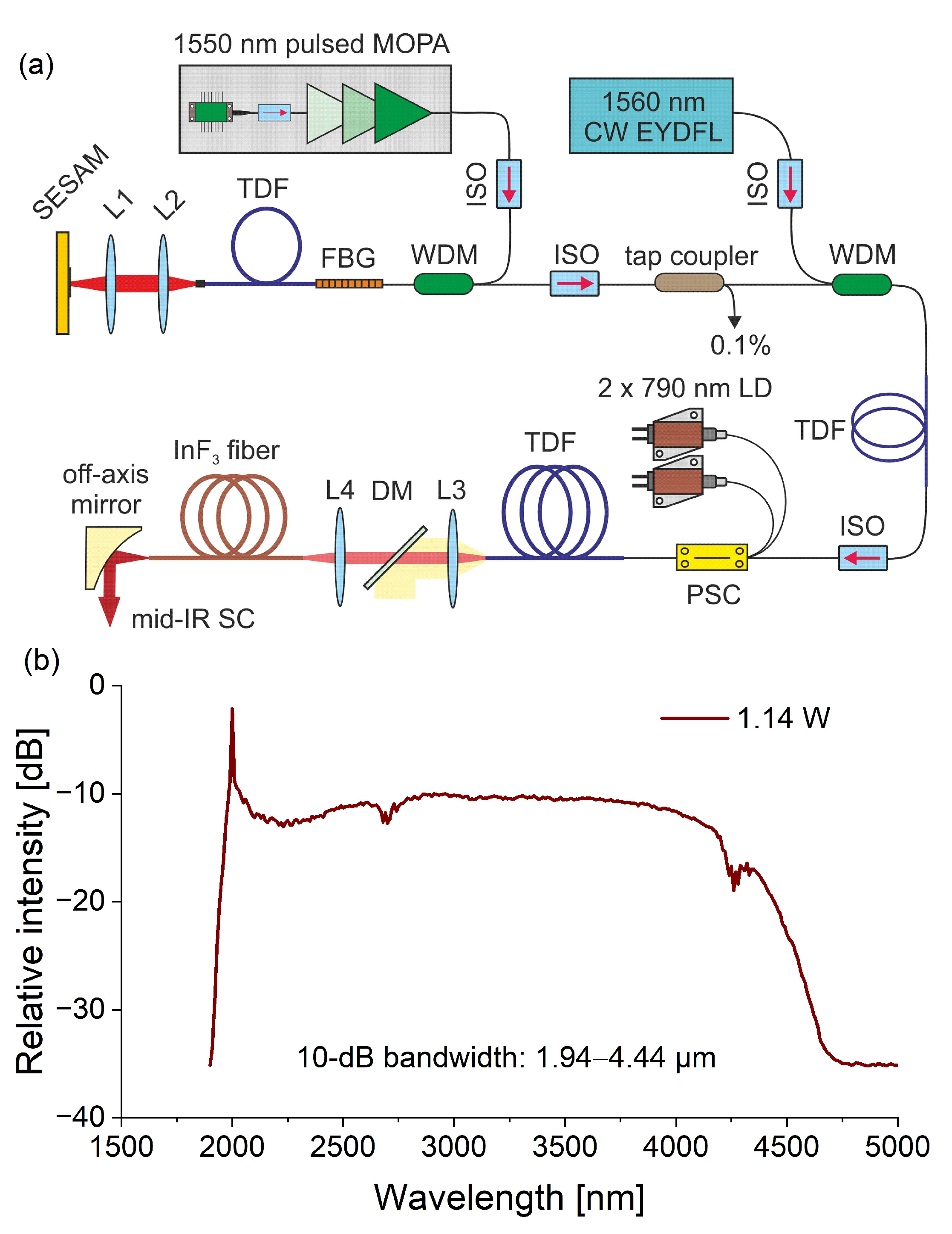
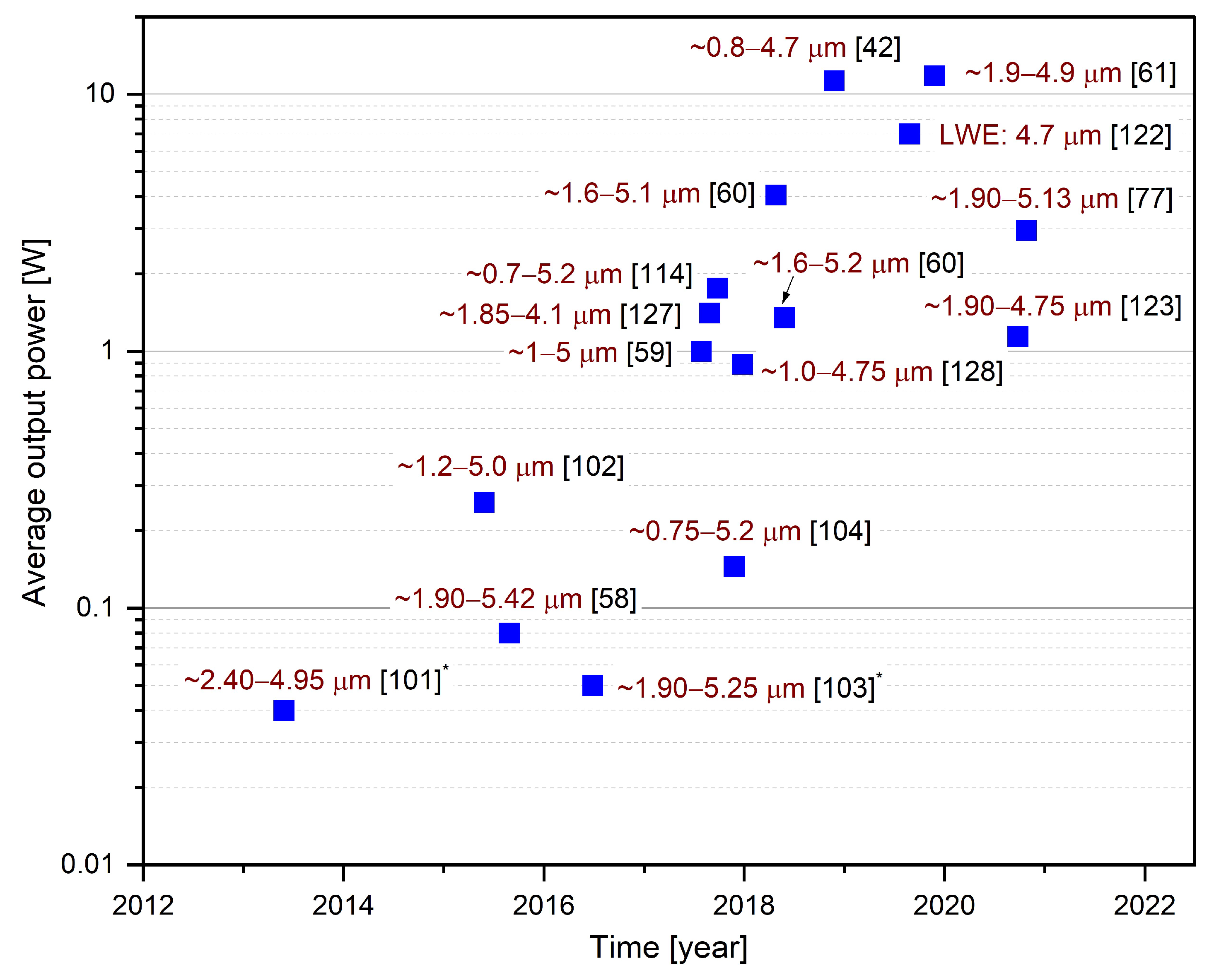
| Pump Source Architecture | Pump Parameters (Pulse Width/PRF/Wavelength/Average Power) | InF3 Fiber Parameters (Core Diameter/NA/Fiber Length) | SC Parameters (Average Power/LWE/Spectral Flatness) | Ref. |
|---|---|---|---|---|
| OPG | 70 fs/INP/ 3.4 µm/INP | 16 µm/0.14/9.5 m | INP/4.95 µm/ 20 dB@ 2.7–4.7 µm | [101] |
| MOPA: MLFL (seed), 1 × EDFA, 1 × TDFA | 97.5 fs/50 MHz/ 1.55 µm/0.57 W | 7 µm/0.26/0.55 m | 247 mW/~5 µm/ INP | [102] |
| MOPA: OPG (seed), Er3+:ZrF4 amplifier | 400 ps/2 kHz/ 2.75 µm/INP | 13.5 µm/0.3/15 m | 8 mW/5.42 µm/ 20 dB@ 2.4–5.4 µm | [104] |
| OPG | 70 ps/1 kHz/ 2.02 µm/INP | 9 µm/0.26/9 m | INP/5.25 µm/ 5 dB@ 2.0–5.0 µm | [103] |
| MOPA: OPG (seed), Er3+:ZrF4 amplifier | 400 ps/20 kHz/ 2.8 µm/INP | 13.5 µm/0.3/14 m | 145 mW/~5.4 µm/ 20 dB@ 2.77–5.30 µm | [58] |
| MOPA: DFB laser (seed), 1 × EDFA, 1 × EYDFA, 2 × TDFA | 50 ps/1 MHz/ 1.55 µm/2.3 W | 9.5 µm/0.3/20 m | 1 W/~5 µm/ 6 dB@ 1.91–4.77 µm | [59] |
| MOPA: DFB laser (seed), 2 × EDFA, 1 × EYDFA, 2 × TDFA | 1 ns/5 MHz/ 1.55 µm/3.7 W | 9 µm/0.3/12 m | 1.41 W/4.1 µm/ 10 dB@ 1.91–3.59 µm | [127] |
| MOPA: DM laser diode (seed), 3 × TDFA | 35 ps/1 MHz/ 1.95 µm/INP | 9 µm/0.26/10 m | 1.76 W/~5.2 µm/ 3 dB@ 2.5–4.37 µm * | [114] |
| MOPA: DFB laser (seed), 1 × EYDFA, 2 × TDFA | 50 ps/1 MHz/ 1.55 µm/2.03 W | 9.5 µm/0.3/12.7 m | 0.88 W/~4.7 µm/ 10 dB@ ~1.9–4.4 µm | [128] |
| MOPA: DFB laser (seed), 2 × EYDFA, 1 × TDFA | 1.6 ns/100 kHz/ 1.55 µm/2.27 W | 7.5 µm/0.3/10 m | 1.35 W/5.2 µm/ 10 dB@ ~2.02–4.91 µm | [60] |
| MOPA: DFB laser (seed), 2 × EYDFA, 1 × TDFA | 1.6 ns/1 MHz/ 1.55 µm/6.41 W | 7.5 µm/0.3/10 m | 4.06 W/5.1 µm/ 10 dB@ ~2.09–4.65 µm | [60] |
| MOPA: MLFL (seed), 2 × TDFA | 60 ps/33 MHz/ 1.956 µm/17 W | 7.5 µm/0.3/11 m | 11.3 W/4.7 µm/ 20 dB@ ~1.85–4.53 µm * | [42] |
| QML fiber laser (single oscillator) | QS: 90 ns/60 kHz/~2 µm/10 W ML: 30 ps/37.9 MHz | 7.5 µm/0.3/15 m | 7 W/4.7 µm/INP (LWE@10 dB: ~3.1 µm) | [122] |
| MOPA: DFB laser (seed), 1 × EYDFA, 1 × TDFA | 1 ns/1.5 MHz/ 1.55 µm/18.3 W | 7.5 µm/0.3/11 m | 11.8 W/4.9 µm/ 10 dB@ 2.05–4.60 µm | [61] |
| MOPA: DFB laser (seed), 2 × EDFA, 1 × EYDFA, 1 × TDFA | 0.9 ns/0.5 MHz/ 1.55 µm/~4.5 W | 7.5 µm/0.3/12 m | 2.95 W/5.13 µm/ 10 dB@ 1.96–4.97 µm | [77] |
| MOPA: GSML fiber laser (seed), 2 × TDFA | GS: 120 ns/50 kHz/2 µm/1.85 W ML: ~110 ps/111 MHz | 7.5 µm/0.3/11 m | 1.14 W/4.75 µm/ 10 dB@ 1.94–4.44 µm | [123] |
Publisher’s Note: MDPI stays neutral with regard to jurisdictional claims in published maps and institutional affiliations. |
© 2022 by the author. Licensee MDPI, Basel, Switzerland. This article is an open access article distributed under the terms and conditions of the Creative Commons Attribution (CC BY) license (https://creativecommons.org/licenses/by/4.0/).
Share and Cite
Swiderski, J. Recent Development of Mid-Infrared Supercontinuum Generation in Fluoroindate Glass Fibers. Appl. Sci. 2022, 12, 4927. https://doi.org/10.3390/app12104927
Swiderski J. Recent Development of Mid-Infrared Supercontinuum Generation in Fluoroindate Glass Fibers. Applied Sciences. 2022; 12(10):4927. https://doi.org/10.3390/app12104927
Chicago/Turabian StyleSwiderski, Jacek. 2022. "Recent Development of Mid-Infrared Supercontinuum Generation in Fluoroindate Glass Fibers" Applied Sciences 12, no. 10: 4927. https://doi.org/10.3390/app12104927






